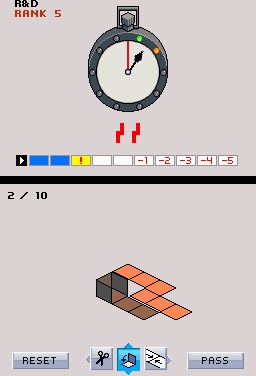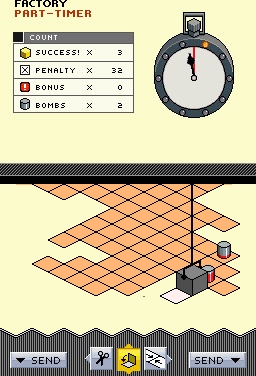Have you ever dreamed of working in a factory where you spend your days cutting out shapes that, when folded correctly, form perfect cubes? Probably not, but if Art Style: Boxlife is any indication, it might be a far more stimulating career path than you think. Available exclusively from the Nintendo DSi Shop, this deceptively difficult puzzle game presents you with irregularly shaped pieces of grid paper and then challenges you to cut and fold them to make as many cubes as possible with as little waste as possible. There are 11 different shapes that can be cut out and folded to make cubes, and you need all of them in your geometric arsenal to stand a chance of making it through Boxlife's later levels.

You view Boxlife from an isometric perspective and play primarily with the stylus, which, by tapping small tool buttons on the touch screen, can be switched between three different functions. You can use the stylus to cut straight lines and right angles, you can use it to fold along those same straight lines, and when you make a mistake, you can use it to reattach pieces of paper that you've cut. The controls can be a little fiddly because you're making such small movements with the stylus, and the option to select tools using face buttons rather than the touch screen is worthless, but Boxlife is still a very easy game to pick up. It would be a relatively easy game to beat as well, except that every level is played against the clock.
There are two modes of play in Boxlife: R&D and Factory. In R&D, you're not allowed to waste any paper whatsoever. Each of the 12 levels presents you with 10 different-shaped pieces of paper, and each piece of paper has to be turned into two to five cubes. Figuring out how the different cube nets tessellate can require a lot of trial and error, which is rarely something that you have a lot of time for. If you're stuck on a particular piece of paper for more than 20 seconds or so, you'll be shown pictures of the shapes needed for one possible solution to the puzzle. This is extremely helpful if you're completely blanking, but it's distracting if you're close to reaching a different solution. Paper shapes will start to repeat if you reattempt a level a few times, which makes things a little easier if you're able to remember how you completed them previously. That's a lot harder than you might think, though, because all the puzzles in Boxlife look similar. You don't need a perfect score to progress to the next level in R&D mode, but you do need a very good one, and managing to make three cubes from a piece of paper that's large enough for four scores you no points whatsoever.
Factory mode is quite different. You're still penalized for waste, but your goal is to make as many cubes as possible from an infinitely long piece of paper that you can scroll down the screen like it's on a conveyor belt. Any paper that drops off the bottom of the screen is wasted, and as you progress to more difficult levels, your job is made more challenging by bombs that randomly drop onto your workspace. The only way to get rid of these bombs is to wrap a box around them. If you fail to do so, the bombs explode, scorching the surrounding paper squares and rendering them unusable. Your shifts in the factory last for around three minutes, and your score at the end takes the form of a pay packet that takes waste, boxes made, and bombs successfully disposed of into account. Oddly, every dollar that you earn automatically goes toward buying items to beautify a small boxlike home and garden that appear on the title screen. These home improvements aren't particularly compelling, but they at least offer some incentive to keep playing Factory mode after you've unlocked all eight of its levels.
Both of Boxlife's modes keep track of your previous scores, and every time you set a new score it's plotted on a graph so you can see if you're improving. This isn't as compelling as being able to compare your scores with those of your friends, but it gives the game some replay value, though you're still unlikely to return to any of R&D's levels after you achieve a perfect score of 100 on them. Getting perfect scores across the board isn't something you're likely to accomplish quickly, but Boxlife is definitely one of those games that make you feel like you'll improve if you try just one more time. Before you know it you've spent an enjoyable hour or two trying to get past the same level, and the asking price of 500 Nintendo points ($5 US) feels like money well spent.

Everything about Boxlife's pleasing visual style looks like it could have been designed on isometric graph paper. In-game there's not much to look at, but the minimalist style and bright colors work well because they're never confusing and you can always see the shapes that you're working with clearly. Outside of the playing area, the boxy aesthetic carries across to the small factory worker character that represents you (his outfit changes as you progress and earn promotions) and to his home on the title screen, where your cube-shaped cat will sit in the perfect square garden and stare for hours at the square wheels on your bicycle. Boxlife's audio is every bit as playful as the visuals. Chirpy electronic-sounding tunes are ever-present and are interrupted only by an alarm that sounds to warn you when you have 30, 20, and 10 seconds remaining and by cries from random animals (monkeys, elephants, and horses) that play any time you complete a puzzle in R&D mode.
Like other games in the Art Style series, Boxlife has a pleasing, simple look that belies its challenging gameplay. This isn't a game that you'll want to play for extended periods of time, but it's good enough that you'll keep coming back to it long after you've completed your first shift at the box factory.